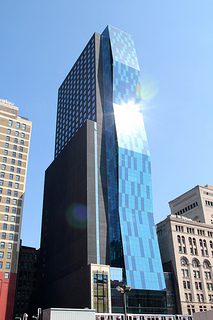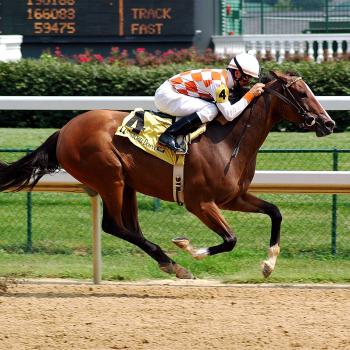
You can’t miss it on the Chicago lakefront skyline, a dramatic building standing out from its neighbors and reflecting the waters of Lake Michigan — the new dormitory and classroom building for Roosevelt University, a non-profit, historically commuter school in Chicago. According to their US News’ profile, they’re labelled “selective,” admitting 75% of applicants, they ranked 112th among “regional universities,” have an enrollment of about 6,000 (3,800 undergraduates), and charge 27,000 in tuition. And they’re in a risky financial situation.
Typically when Glenn Reynolds/instapundit.com speaks of the Higher Education Bubble, it’s in the context of drops in enrollment at certain universities or programs of study (e.g., law school) or the potential of MOOGs and other forms of non-traditional learning to disrupt the 4-year degree, high-tuition, residential college, model. But the Chicago Tribune last weekend (sat on my facebook page) featured a case of a university whose actions and fate are very similar to the housing borrowers and lenders in the housing bubble, Roosevelt University, in “Three years after building skyscraper, Roosevelt University plans cuts.”
What happened? The Trib reports:
But in the three years since it opened, the $123 million building on South Wabash Avenue has come to seem more like a millstone than a monument to Roosevelt’s educational mission. Interest payments on the school’s massive construction loan have ballooned, and Roosevelt had to begin paying back the principal this year, adding to the budget pressure.
Tuition revenues have fallen far short of the projections that the private nonprofit school used to justify the tower. In 2009, amid a nationwide economic crisis, Roosevelt finance officials had predicted a $40 million jump in annual tuition dollars by 2014. The actual increase was about $5 million.
Today, analysts expect the university of about 6,000 students to run a deficit for its fifth year in a row. Annual salary increases have been frozen, according to an analyst’s report. Debt payments are absorbing 11 percent of Roosevelt’s operating budget, nearly double the typical debt burden at financially healthy universities. And enrollment is actually lower than it was the year construction began on the Wabash building.
The bottom line? Even though they were making their decisions in the aftermath of a major financial crisis, the administration still bought into a mentality that university attendance rates are headed in one direction: up.
Over the next two years enrollment remained flat. But university officials continued to predict dramatic increases, telling Moody’s in 2011 that it planned to double its student body to 10,000 over the next 10 years.
They were counting on students, especially their target of fresh high school graduates, being wowed at the opportunity to live in a Loop skyscraper-dorm, and overlooking all the other pros and cons of the university. Instead:
[The university] succeeded in drawing more traditional college students — partly because Roosevelt was accepting an increased percentage of its applicants. About 270 more freshmen enrolled in fall 2014 than in 2006, bringing the total freshman class to 607 and helping increase the percentage of students aged 18-24 from 46 percent in 2007 to 66 percent in 2014, according to documents filed in connection with the school’s bonds.
But that growth was slower than predicted and the university was losing students it had historically served.
Since 2006, the population of undergraduates attending Roosevelt part time has dropped by more than half, to 840 in 2014. The graduate student population is down by more than a quarter.
There’s a lesson to be learned here. But are universities leaning that lesson?
One of the first commenters at the article says no: Northeastern Illinois University , a nonselective commuter school in northwestern Chicago is building its first dorm, too. This went mostly unnoticed, but the article at WGN quotes the university: “University President Sharon Hahs points to declining enrollment and says dormitories are needed.” Illinoispolicy.org also reports on their use of eminent domain and again points to university statements that dorm construction is intended to counter enrollment declines. There’s no mention of cost, and, after poking around a bit, I found an article on the student newspaper site that says that this is because they’re leasing the land to a private company, American Campus Communities. On this company’s web page, they describe the housing not as an affordable place for students to live, but instead say:
Live like you mean it at The Nest, the best in Chicago student living! At The Nest you will have the privacy and lifestyle you deserve in a student community that is built specifically with you, the college student, in mind.
Take advantage of our convenient location and unmatched amenities—everything you want and need in one place makes The Nest the best in college living! The Nest is located centrally on campus at Northeastern Illinois University in Chicago, IL. You will also enjoy our amenities including a fitness center, computer center with Mac computers, recreation lounge with billiards, foosball, air hockey, and much more.
The Nest offers fully furnished, 2 bedroom, 2 bathroom apartments and 4 bedroom, 2 bathroom apartments, individual liability academic-year leases and ALL utilities are included—cable, internet, electricity (up to a monthly cap), and water. You can also choose from private or shared accommodations.
Now, this is Chicago and the university is located in, if not a hot market, then at least a satisfactory one. Perhaps the developer has an “out” that they can lease to nonstudents if there aren’t enough takers among the student body. From what I can see, these will be far more expensive than neighboring apartments — the 2 bedroom option is $4,000 per semester, per person, with each bedroom shared by two students — which works out to more than $2,500 per month. There’s no cafeteria, so there’s none of the cafeteria price-gouging, at least, and I suppose they provide the benefit to students of coming furnished and providing individual leases. But this still looks rather pricey, and rather risky as a financial venture.













